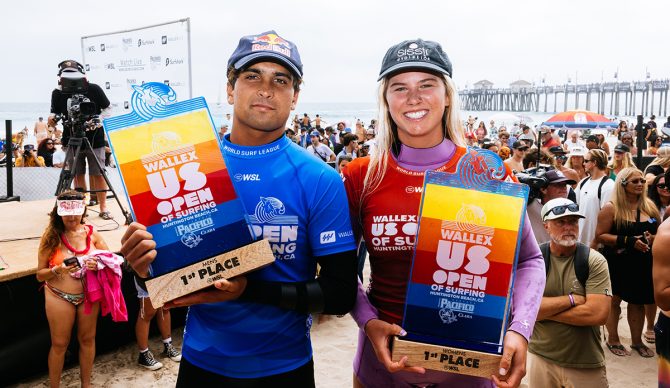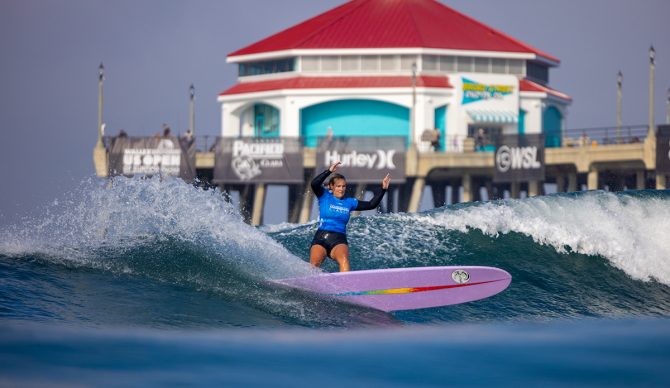
Winner, winner – Sawyer Lindblad and Eli Hanneman. Photo: Pat Nolan//World Surf League
It was as if I’d been sucked into some kind of time-space continuum vortex. There I sat under a tented pavilion where Main Street meets the Pacific Coast Highway in Huntington Beach. The busy intersection had been blocked off so that an elaborate stage could be set up, complete with a podium, posters and potted palms; the 35th Annual Huntington Beach Surfing Walk Of Fame Awards was in full swing.
Well attended, too, with all the folding chairs in the seating area occupied and throngs of associated bystanders crowding the adjacent sidewalks, forcing the seemingly endless parade of harried parents herding rashguard-wearing fourth-graders to keep close track of their young surfers. Gaggles of teen-aged girls in bikini tops and teeny cut-offs blended with nondescript Main St. shoppers wondering if they should pick up a pair of “What The Duck?” prints at Sock Harbor or a Firewire “Mashup” at Huntington Surf and Sport. Straw-hat and “Old Guys Rule” t-shirt-wearing vintage VW van owners enjoyed their spots on the pavement (how early did they have to get down here to get parking and set up their exhibition?), while scary biker dudes in Levis and black leather vests (no shirts) holding scarier pit bulls on sturdy leashes intermixed. Even on a Thursday morning at 10:00 a.m., this had to be one of the craziest crosswalks on earth.
Of course, all that’s just a typical summer morning in Huntington Beach. Not typical, at least not for me, was the crowd I was sitting amongst on this particular summer morning. Across the aisle I saw David Nuuhiwa, silver-haired, straight-backed and fabulous; King of the Southside, in his youth he won both junior and men’s U.S. titles here. A few chairs over sat Iilima Kalama, men’s winner at the 1962 U.S. Championships held at the pier, looking frail yet stylish in his flowered paniolo hat. In front of me sat Chuck Linnen, Huntington Beach’s “Ironman”, who competed in events under the shadow of the pier throughout nine presidential administrations, while next to me sat Jericho Poppler, perennial finalist here throughout the late 1960s and 1971 U.S. Women’s Champion.
As if this lineup wasn’t impressive enough, at the end of my row sat the ageless, relentlessly innovative Herbie Fletcher, a former H.B. Pier local who in 1965 was runner up to Nuuhiwa in the United States Surfing Association’s junior division (and who pretty much invented modern surfing, just ask him). While up on the stage, standing at the podium next to 1976 World Champion Peter “PT” Townend, who though growing up on Queensland’s Gold Coast has been living in Huntington Beach since the early 1980s, fidgeted Australia’s Cheyne Horan, winner of the inaugural OP Pro in 1982 and one of honorees at this year’s Walk Of Fame Awards, entertaining the audience with a spirited account of how he took out the ‘82 final against Shaun Tomson with help of a “Hail Mary” backside 360.

Taka Inoue, getting in on the festivities. Photo: Kenny Morris//World Surf League
What’s the big deal, one might say, with H.B.’s Walk Of Fame obviously leaning toward the legendary when setting down their plaques in wet Main St. cement. But it wasn’t the remarkable group of assembled legends, local and otherwise, surrounding me that put the zap on my head (you find yourself saying things like this when sitting near Herbie), but what was going on in the background. Because at the same time Cheyne regaled us with his dramatic OpPro win, he was competing against the voice of Kaipo Guerrero, whose amplified commentator’s voice could be heard echoing back across the sand, stridently describing what was sure to be at least a six-point-plus ride by Luana “Lulu” Silva, as she handily worked over a glassy, four-foot Southside peak.
Yep. Right across PCH from the Walk Of Fame pavilion the perennial U.S. Open of Surfing was up and running, with its own tent and pavilion city set up on the very same sand south of the Pier that has been hosting the event, in some incarnation or another, since 1959; same waves in which some of the folk surrounding me had hoisted their trophies 40, 50 and even 60 years ago. Which is precisely why, regardless of feelings concerned with gridlocked Orange County freeways, hectic Beach Blvd. traffic, gaudy used car lots, tacky strip malls, funky liquor stores, larcenous parking meters, the stink of waffle cones and motorcycle exhaust, heedless bicyclists and Rollerbladers, weirdoes under the Pier with hyacinth macaws on their shoulders, 15-dollar burritos, burning sand, overflowing port-a-potty’s, packed bleachers and pier, blown out, low tide afternoon finals and the dreaded “Huntington Hop,” we all should be grateful that the US Open of Surfing keeps on rollin’. Because, to blatantly steal a phrase, it’s still one of the greatest shows on surf.

The most used surf venue in existence. Photo: Pat Nolan//World Surf League
Keep reading, because here’s the deal: the US Open of Surfing is real. Meaning, it’s anti-Internet. Sure, you can watch it on your phone, but unlike so many other big time surf contests that get held in parking lots (think Margaret River and J-Bay), or at the end of a road (and unless you know someone who knows someone important you can forget about getting a spot on one of the boats in the Teahupo’o channel) or, even worse, in the back yard of someone who doesn’t know you or want you there (ever sat on the beach at Pipeline, sneaking a glance up at the Volcom House?), the U.S. Open of Surfing, with its over-the-top, stadium-like atmosphere, is all about the spectacle of competitive surfing. To attend is to take part in the whole crazy circus, and from saving your spot in the bleachers so you can hit the food stalls (or one of the many outhouses, depending on which stall you visit), to fighting for elbow room on the pier to cooling off in the shore break before Chris Cote chases you away, this is an immersive, tactile experience. Sort of like going to Chavez Ravine for a Dodger game – except barefoot. Or to an outdoor Jimmy Buffett concert (well, okay, you and your parents would probably already be barefoot, but you get the picture.) Thing is, professional surfing never looks, sounds, feels and smells as much like professional surfing than it does here at the Huntington Beach Pier on a hot summer day.
And the surfing? All I can say to you so-called contest fans out there who think that surf competitions should only be held in gnarly slabs like Teahupo’o, The Box or maybe 20-foot Cloudbreak, let me tell you something: those are wave-catching contests – anyone who can pull in and hang on will win if they get the right wave. But do you want to talk about drama? Try catching a three-foot, low tide south swell wedge off the Pier with 20 seconds left in your heat, pull off two decent outside top turns, then without looking like a puppet with its strings cut connect all the way through to the shore break where, channeling former champs like Cheyne Horan, you try to pull off your own “Hail Mary” at the feet of the multitude on the sand. That takes real nerve, real skill, man. Really separates the men from the boys, and the women from the girls (although sometimes an especially talented boy or girl surfer will take down some bigger names for the top honors, and that’s neat, too.)

Photo: Tommy Pierucki//World Surf League
But the thing that really makes the US Open of Surfing great is that it truly is where competitive surfing tradition lives. On the pier, where spectators have gathered to watch the action below since before there was surf wax; where competitors have been shooting that pier since when they used to have to wear helmets; where if you set up a time-lapse camera back when NASA’s Mercury Seven astronaut program was first formed and then let it run until tomorrow, you’d see surfers riding everything from Harbour “Trestles Specials” to Haydenshapes “Hypto Kryptos,” from Weber “Performers” to Mayhem “Uber Drivers,” from Clyde Beatty “Rocket Fish” to Britt Merrick “Rocket Wides.” And where today so many of the world’s best surfers, who otherwise could be off on some fantasy summer surf trip somewhere, still gather to make their mark in the sport’s last and only real-life surf contest. Hoping that some day years hence they find themselves sitting under that tent at the corner of PCH and Main, taking their rightful place among the legends of our sport.

